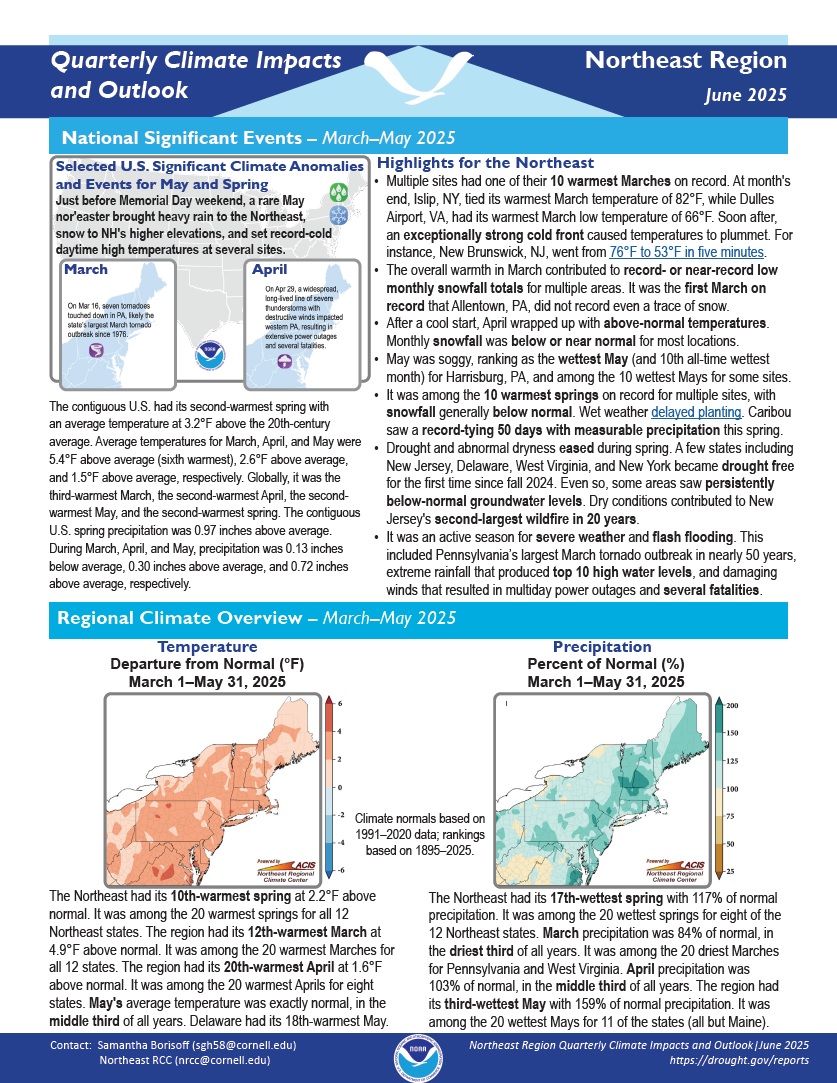Quarterly Climate Impacts and Outlook for the Mid-Atlantic Region for March–May 2025. Dated June 2025.
Quarterly Climate Impacts and Outlook for the Canadian and U.S. Prairies and High Plains for March–May 2025, with an outlook for July–September 2025. Dated June 2025.
Spring brought above-normal temperatures across the Prairies and High Plains, especially in the western Canadian Prairies, and portions of Montana, the Dakotas and Minnesota. The Prairies and High Plains saw drier-than-normal conditions overall, with the Canadian Prairies, particularly in Manitoba, Saskatchewan, southern Alberta, and much of Montana experiencing precipitation well below normal for the season.
NOAA’s National Integrated Drought Information System (NIDIS) and Physical Sciences Laboratory are partnering with the California State Climatologist/California Department of Water Resources, NOAA’s National Weather Service and National Centers for Environmental Information, and the California-Nevada Adaptation Program (a NOAA CAP team) on the Sector-Specific Drought Early Warning Outlook – Southern California Pilot.
Quarterly Climate Impacts and Outlook for the Southern Region for March–May 2025. Dated June 2025.
Spring temperatures were above normal for the entirety of the Southern Region, with most stations running 1°F to 4°F above normal. Most of the Southern Region experienced above-normal precipitation for spring. Stations across much of Oklahoma, Mississippi, Arkansas, Louisiana, Tennessee, North Texas, Deep South Texas, and the Texas Panhandle received 110% to 300% of normal precipitation.
Quarterly Climate Impacts and Outlook for the Gulf Coast Region for March–May 2025. Dated June 2025.
Spring temperatures were above normal for the entire Gulf Region, with most stations observing 1°F to 5°F above normal. Precipitation was above normal across much of the Gulf Region in spring, with many stations averaging 150% to 300% of normal precipitation in Deep South Texas, Southeast Texas, much of Louisiana, Mississippi, and Alabama.
Quarterly Climate Impacts and Outlook for the Great Lakes Region for March–May 2025. Dated June 2025.
Spring temperatures ranged from 2°F (1°C) below normal to 4°F (2°C) above normal. Spring precipitation for the basin was 116% of average, with all basins having near or above-average precipitation.
Quarterly Climate Impacts and Outlook for Alaska and Northwestern Canada for March–May 2025, with an outlook for July–September 2025. Dated June 2025.
ECCC, NOAA, and partners created these outlooks to inform the public about recent impacts within their respective regions. Each regional report contains easy-to-understand language, and anyone can access them through the U.S. Drought Portal.
Quarterly Climate Impacts and Outlook for the Western Region for March–May 2025. Dated June 2025.
Spring temperatures were near to above average for most of the West, with some pockets of below-average temperatures along the California coast and in other parts of the Southwest. In large swaths of the West, less than 70% of average precipitation was observed. Less than 50% of average precipitation was observed in parts of north-central California, southern Arizona, and southwest New Mexico.
Quarterly Climate Impacts and Outlook for the Missouri River Basin for March–May 2025. Dated June 2025.
Spring began on a warm note, with dozens of counties in Kansas, Nebraska, and South Dakota ranking in the top 5 warmest. Precipitation was above normal in the western parts of the Dakotas this spring due to abundant rainfall in the latter half of May.
Quarterly Climate Impacts and Outlook for the Northeast Region for March–May 2025. Dated June 2025.
The Northeast had its 10th warmest spring on record at 2.2°F above normal. It was among the 20 warmest springs for all 12 Northeast states. The Northeast as a whole had its 17th wettest spring with 117% of normal precipitation. It was among the 20 wettest springs for 8 of the 12 Northeast states.











